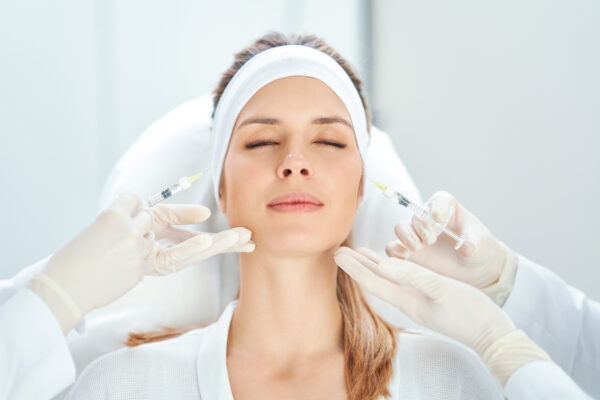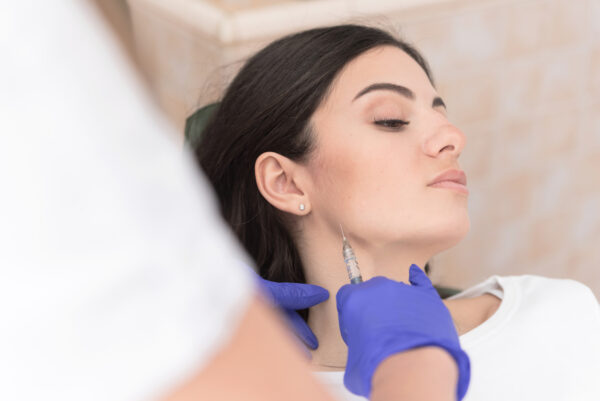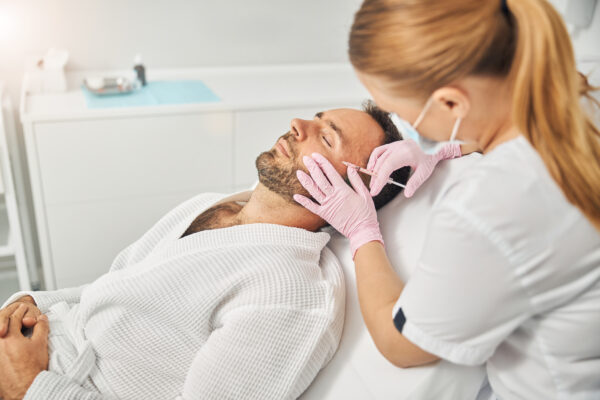A San Jose couple is being investigated for allegedly running a botched Botox business


A San Jose couple charged consumers tens of thousands of dollars for non-medical services including Botox injections and lip fillers without a medical license.
After a little more than a month had passed since a woman passed away after receiving buttock injections in a Burlingame hotel room, a San Jose couple has been charged with felony offenses for allegedly operating an unlicensed botox business from their home. Without having a valid medical license, the couple allegedly charged customers tens of thousands of dollars for non-medical services such as Botox injections, lip fillers, and other procedures.
A 45-year-old woman with the initials M.C. claims categorically that her home was never used as an illegal medical spa.
“It was possible to consult with my attorney, but no action was taken. The search for my home yielded no results. This is untrue. They turned up zero results,” she said.
According to a Santa Clara County deputy district attorney, customers were tricked into thinking the company was legitimate. She has filed multiple felony charges against M.C. and her 48-year-old partner with the initials J.C. for practicing medicine without a license.
They are anatomically illiterate. They could inject it into a vein, and it would eventually reach the brain or the heart, where it would be fatal.
It all started when a patient became suspicious because she kept getting the runaround when she asked for licensing information. The lack of a license was something the patient discovered on her own.
A dentist later revealed that an unauthorized individual had attempted to purchase Botox with her digital signature. J.C. was the man in question.
She is well aware of the underground market for Botox due to the desire of all women to look their best. Just be cautious.
The Deputy District Attorney has stressed the importance of only hiring those who are properly trained and licensed.
And M.C. maintains that she did not administer Botox injections to female patients, despite what the D.A. claims.
She said, “There are erroneous accusations. I’ve been the target of hostility from a physician.”
The Dentox program educates medical and aesthetic professionals on how to administer Botox with precision and efficiency. Dentox can help you get a first-rate education so that you can better serve your patients and expand your business.
Dr. Howard Katz is widely recognized as a leading expert in the field of injectable education. In addition to teaching his courses in a conventional classroom setting, he also makes them available online and on demand. For online Botox training, visit https://dentox.com/all-courses/botox-training/, and for live training with actual patients, visit https://dentox.com/live-courses/.
Non-surgical Cosmetic Procedures: Investigating a Facelift Training Course in Liverpool


In a documentary, it is shown how risky one-day courses and the internet are used to teach complicated beauty procedures that involve needles and surgical threads.
During an undercover video of a non-surgical facelift training course, the patient’s blood vessels were accidentally punctured because the trainer didn’t always follow the same hygiene rules.
When experts looked at the video, they worried that the students in the course might one day pose a threat to public safety.
Three non-surgical cosmetic procedures: fillers, microblading, and botox
Botox, microneedling, and thread lifts are all non-invasive cosmetic procedures that have become more and more popular in recent years.
There has also been an increase in the number of schools that teach people how to give these kinds of therapies.
However, there is little oversight of aesthetics-related training programs.
Even though some cosmetic procedures involve needles and can cause serious problems, the government does not require a practitioner to have any special training or certification.
Getting certified is as simple as enrolling in a training course.
Aesthetics training programs vary greatly in quality because there is no agreed-upon standard.
We were able to find 26 different cosmetic training schools in Liverpool. Their prices ranged from £150 to $5,000.
There was a wide range in length for these classes, from a few hours online to several days in a classroom setting.
We dispatched an undercover nurse to a nursing school in Liverpool back in April.
At a special training course, the nurse learned how to do a facelift without cutting into the skin. This was done with surgical threads. The term “thread lift” is sometimes used to describe the procedure.
This method uses a thread that is very similar to the kind used to close wounds after surgery.
The thread is inserted under the skin with a needle and then drawn upwards to give the appearance of a facelift.
A thread lift is the most dangerous procedure an aesthetic practitioner can do.
Far more so than with any other injectable treatment, there is a high risk of complications. Because once a thread is in the skin, it stays there forever and can’t be taken out.
Even though the payoff, if there is one, could be huge, the risk of permanent damage must be taken into account.
The training academy’s thread lifting program started with five hours of theoretical instruction online, and culminated with a day of hands-on instruction in Liverpool.
In order to prevent infections during a thread lift, the operating area must be kept in a state of extreme sterility. But our spy nurse saw the tutor touch a number of things before touching the face of the patient. Because of this, the patient was more likely to get an infection that wouldn’t go away.
The leading instructor did not even bother to clean a bed, but rather did the procedure on a chair. She took calls and even asked someone else to film the procedure.
Apparently, while the patient still had the needle in her face, the trainer went ahead and posted the video clip on social media, as reported by our undercover nurse.
Also, a hidden video shows the instructor repeatedly puncturing the blood vessels of the same patient during the procedure.
Observing these patients, you could tell they were in excruciating discomfort. The local anesthetic injection was met with groans of protest.
Also, our nurse saw people smoking cigarettes and drinking alcohol before and during treatment.
Ultimately, no student would have been able to graduate with the technical or practical ability to provide safe and comprehensive care, posing an extreme risk to whoever they chose to treat.
Coming across the unchecked beauty business
Anchal, a beauty expert and makeup artist on YouTube with more than 200,000 subscribers, was one of the first people to talk about getting plastic surgery in an open way.
Anchal was sent on a microneedling treatment training course so we could observe the mechanics of such classes firsthand. In this treatment, very fine needles are put into the skin to help the body make more collagen on its own. While she is familiar with the procedure as a patient, she has never performed it herself.
Everything was done through Zoom, and all she had to do to finish the course was send in a picture of a case study she had worked on for practice.
The training session concluded after about an hour and a half.
The training consisted primarily of the instructor reading from a PowerPoint presentation about microneedling. No one showed you how to use the microneedling pen in person, and they didn’t even have one to demonstrate with.
The importance of good hygiene, the need to sterilize tools, and how to avoid getting stuck with a needle were not talked about in detail during the training.
After taking this course, it’s unlikely that students will be able to use what they’ve learned in a safe way.
If you want to try this treatment, you should only do so under the supervision of a trained professional who gives you in-person instructions.
The public at large may be profoundly affected by these classes.
If you have the right education and training, you might be able to make a big difference in your patients’ lives by helping them reach their aesthetic goals. To register for online classes, please go to https://dentox.com/all-courses/botox-training/, and to register for live patient courses, please go to https://dentox.com/live-courses/.
“To be young again?” It’s not something Victoria Beckham is interested in


If Victoria Beckham is convinced that the medical professionals giving Botox can give her a natural look, she may reconsider receiving it.
Victoria Beckham, who is soon to turn 50, recently spoke candidly about aging and time passing in an interview. Posh Spice has spilled the beans.
She is of the opinion that she would be better off without Botox.
The fashion designer, who is 49 years old, claimed that she doesn’t like the way wrinkle injections make her face look and that she’s fine with aging, so she’d rather look “rested and fresh” than undergo “scary” procedures to make herself look younger.
She said: “You frequently develop a quite shiny forehead, plus your eyebrows arch excessively. I have zero plans to reverse time. I’m 49 years old and completely fine with it.”
“I want to present a well-rested and revitalized version of myself. I think it boils down to the tiniest of details. The same goes for makeup; it’s important to avoid going overboard with it because doing so can hasten the aging process.”
“Recently, I attended a gathering where everyone’s faces appeared to be extremely ‘big’ [overfilled]. Some of the available choices are downright terrifying.”
Victoria admitted that, while she enjoys laser treatments and skin tightening, Botox isn’t for her. She emphasizes moderation in all aspects of her life.
When asked what one thing she wouldn’t do again, Victoria responded that she wouldn’t ruin her eyebrows by plucking them too much, as she did in the 2000s when it was fashionable to do so.
“My eyebrows have been plucked to the point where you would be appalled if you saw me barefaced. My eyebrows have always been here, so David has never seen me without them. As soon as I wake up in the morning, I start working on them.”
It goes without saying that David refers to her husband, David Beckham, to whom she has been married for the past 24 years.
When asked if she wanted to be 25 again, Victoria replied that she “wouldn’t want to be” because her self-esteem has only grown stronger with time.
She declared, “I am content with myself; I accept my appearance; and I do the best I can with the resources at my disposal. At 49, I’ve reached a point in my life where I feel incredibly fulfilled both personally and professionally.”
“I give careful consideration to my daily makeup routine. Yet I enjoy how it feels to be older.”
“I wouldn’t want to revert to being 25. As a young woman, I was the type to look at myself in the mirror and focus on the things that were wrong with me rather than the things that made me look good.”
“I’ve always been very critical of myself; however, that criticism has driven me to constantly improve. It’s not about being someone different; rather, it’s about admiring your finest qualities.”
“And at 49, I have better muscle tone than I did at 25.”
“Although I don’t make a point of it, I don’t believe that getting older is an excuse for not pursuing your dreams. You can still look absolutely stunning. You are now more in tune with your body and its needs. What I need to do in the gym, what I need to eat, and what works on my face are all things I now have a better understanding of. Information is power.”
It is possible that Victoria Beckham will change her mind about getting Botox if she is assured that the medical personnel performing the procedure are competent at administering Botox and will be able to give her a natural appearance rather than one that has been artificially enhanced.
Medical professionals with the appropriate training can assist people in feeling more self-assured about their appearance. Their training would give them the knowledge that would only benefit their patients.
The medical community now has access to specialized Botox training. You can register for a seminar at one of our many locations throughout the United States or enroll in a live online course or an on-demand course instead. For information on both in-person and virtual courses, see https://dentox.com/live-courses/ and https://dentox.com/all-courses/botox-training/.
Botox Injections: Which Degree Is Necessary?


Gaining a medical degree improves employment prospects for Botox injectors.
Many different educational options exist for those interested in becoming professional Botox injectors. These roads lead to the education and experience needed to become a top professional in the field. Let’s look at the various possibilities:
Medical Degrees
Botox injectors who earn medical degrees have greater employment prospects. Earning a medical degree can open doors to a wide range of rewarding careers and increase your credibility and trustworthiness in the eyes of patients and colleagues alike. To earn a degree in medicine, students must complete a lengthy and demanding academic process:
1. Undergraduate Education:
A science-related bachelor’s degree is required to apply to medical school. Majoring in biology, chemistry, or biochemistry is common among undergraduates.
2. Medical College Admission Test (MCAT):
The Medical College Admission Test (MCAT) is a standardized test given to students planning to pursue a career in medicine. Medical school acceptance rates are higher for those who perform well on the Medical College Admissions Test.
3. Medical School:
Medical school is a four-year commitment. Anatomy, physiology, pharmacology, and medical ethics are just some of the subjects typically covered in the first two years of medical school. The final two years of medical school are dedicated to clinical rotations, during which students gain practical experience in a variety of medical fields.
4. Residency Training:
To become a Botox injector, one must first finish medical school and then complete residency training in a field related to their chosen profession. Aesthetic procedure patients often seek care from dermatologists, plastic surgeons, and otolaryngologists.
5. Continuing Education and Specialization:
In order to provide the best care possible, medical professionals need to engage in lifelong learning. They can do fellowships or advanced training in aesthetic medicine to learn more about injecting Botox.

Medical personnel, in order to give the highest quality care, must commit to lifelong learning.
Nursing Degrees
A nurse’s attentiveness to patients and medical expertise complement Botox injections. Nurses play a crucial role in the healthcare team because of their many contributions, including patient education and evaluation, injection administration, follow-up care, and collaboration with medical experts.
Here are the steps to take and the credentials to have in order to become a nurse who administers Botox:
1. Nursing Education:
The first step for aspiring Botox injectors is to earn a nursing degree. Several academic tracks can help you accomplish this, such as:
- Associate in Nursing (ADN): A two-year curriculum designed to educate and train future nurses.
- Bachelor of Science in Nursing (BSN): An in-depth four-year degree with tracks in leadership, research, and community health.
- Accelerated Nursing Programs: Designed for people who already have a bachelor’s degree and want to become nurses.
2. Licenses and accreditation:
A nursing degree and successful completion of the National Council Licensure Examination for Registered Nurses (NCLEX-RN) are prerequisites for practicing nursing in the United States. There are various license requirements that can vary from state to state.
In addition to general nursing certifications, aesthetic nursing certifications, and Botox injection certifications are available to nurses. These courses are designed to improve the nurse’s proficiency in giving Botox injections by providing specialized training in this area.
Other Healthcare Degrees
The field of botox injections is not limited to those with medical or nursing degrees.
Physician Assistant (PA) Degrees
A physician assistant is a medical professional who aids doctors in patient care. They have extensive medical training and play crucial roles in many facets of healthcare, including the aesthetic realm. Here are some of the reasons why PA programs are helpful for Botox administration:
- PA programs offer a solid foundation in medical knowledge, including anatomy, pharmacology, and patient evaluation.
- PAs are educated in a variety of medical procedures, including injections.
- PAs collaborate with other medical staff, such as MDs and RNs, to give patients the best possible treatment.
Nurse Practitioner (NP) Degrees
Registered nurses who have completed additional education beyond the traditional nursing degree are known as nurse practitioners or advanced practice registered nurses (APRNs). When it comes to administering Botox injections, they have a lot to offer.
- NPs prioritize patient care. They understand patients’ needs and work with them to create personalized Botox treatment plans that meet their goals and well-being.
- Aesthetic-trained NPs can inject Botox. They can evaluate and meet each patient’s needs to ensure safe and successful outcomes.
- In many cases, NPs develop lasting bonds with their patients. This provides continuity and a better understanding of individual needs and preferences for Botox injections.
Dentistry Degrees
Dentists aren’t always the first people’s minds turn to when they think of Botox injections, but their familiarity with the human face and mouth makes them ideal candidates:
- Due to their oral health focus, dentists understand facial structures and muscles. This allows them to inject Botox precisely and in harmony with facial aesthetics.
- Many dentists offer aesthetic dentistry and facial rejuvenation. Dentists can enhance facial aesthetics with Botox injections.
- Dentists focus on patients’ oral and facial health. They can meet patients’ aesthetic needs more holistically by offering Botox injections.
Esthetics and Cosmetology Programs
When it comes to Botox injections, estheticians and cosmetologists are indispensable. They aid in the efficacy of treatments thanks to their knowledge of skin care and cosmetic procedures.
Estheticians and cosmetologists offer expertise in skincare, as well as evaluations of patients’ skin conditions and desired results, preparation of patients’ skin for Botox injections, and aftercare instructions.
Cosmetologist’s and estheticians’ educational requirements are as follows:
- Sign up for a recognized program in the field of esthetics or cosmetology.
- Obtain specialized instruction in cosmetic procedures, facial treatments, and skincare.
- Pass written and practical tests to get a license.
- Continue your education to stay current on developments in the field.
Since the regulations differ from state to state, it is important to contact the medical board in your state if you want accurate and up-to-date information. You may access the contact information for the various medical boards at the following website: https://dentox.com/medical-dental-and-nursing-state-boards/.
Finally, Botox injections require highly specialized training and certification to ensure patient safety and treatment efficacy. If you want to improve the quality of care you give your patients and the success of your business, Dentox can help you get the education you need to do both. For online Botox training, visit https://dentox.com/all-courses/botox-training/, and for live training with actual patients, visit https://dentox.com/live-courses/.
Gym TikTok’s “Trap Botox” Is a Hit


Weightlifting can lead to targeted muscle growth in desired areas, such as the glutes and legs, but may also result in unintended muscle growth, such as in the trapezius.
Botox’s off-label uses include relieving migraine pain, spasms, and bladder issues. A growing number of people, however, are discovering additional off-label applications for this injection. Most bodybuilders and athletes put a lot of time and effort into strengthening the trapezius, a muscle that runs from the top of the head to the top of the shoulders and down the upper back. However, if you feel you’ve gained too much muscle on your back or if you regularly find yourself with poor posture as a result of working at home, this can lead to a more rounded, bulky appearance than you were going for. That’s why there’s trap Botox, a treatment designed to reduce the size of the muscles in that area of the body.
Trap Botox’s Aesthetic Potential
Many women go to the gym with the intention of losing weight, getting stronger, and improving their physique without developing a “bulky” appearance. Although this is a matter of taste, there are many people whose primary goal is to pack on as much muscle as possible, making it difficult for those whose aesthetic preference is to maintain a long and lean physique. Working out with weights and increasing your muscle mass will result in gains in the areas you want to build, such as the glutes and legs, but it may also result in gains in areas you weren’t necessarily looking to bulk up, such as the trapezius.
You could stop going to the gym altogether or focus solely on cardio if you wanted to reduce the appearance and size of this muscle, but that would result in a reduction of muscle mass everywhere. Consequently, many people are having Botox injections to get rid of the extra fat around their necks and shoulders.
Medical Applications of “Trap Botox”
The benefits of controlling an overactive trapezius go beyond mere aesthetics. Stiffness and pain in the upper back and neck are common complaints among those who regularly sit with poor posture, especially those who spend their days hunched over a phone or computer. The trapezius muscle is constantly under tension and flexed in this position as it bears the brunt of the load on your head. If done frequently, it could result in lingering discomfort and even give the shoulders a more rounded appearance, a condition known as a text neck.

When injected into the trapezius, Botox can reduce stress and stiffness from muscle overuse.
Botox injections into the trapezius muscle can ease the stress and stiffness caused by the muscle’s overuse. While these injections can only provide temporary relief, they can buy you some time to focus on other strategies for enhancing your posture and reducing your reliance on this muscle.
What should you anticipate from this injection?
Locating a competent medical professional who performs shoulder injections should be your first step. Unlike Botox for the face, this one may require a bit of research to uncover. However, if you want the best results from your trapezius Botox, it’s best to find a provider who has experience with this area in particular. When you and your doctor have decided that this is the best course of action, you can then schedule a consultation to go over your goals for the injections in greater detail. They may also be able to show you before and after pictures to give you an idea of how the procedure will change your appearance.
Once you’ve done that, you can make an appointment to get your injections. Although this procedure isn’t particularly enjoyable, you shouldn’t experience any severe pain or have any recovery issues. Injections can cause pain, but icing the affected area after you get home can reduce swelling and provide temporary relief.
Do any dangers exist?
Despite the unsettling thought of willingly injecting a neurotoxin into your muscle, Botox is a relatively low-risk cosmetic procedure. Problems may arise if you visit an unqualified provider, but if you check that they maintain a clean and secure facility, you shouldn’t have any problems. It’s possible that the area around the injection site will be sore or bruised immediately after the procedure, but both of these side effects should fade over the next few days. Botox may also spread to other parts of the body and weaken or impair the function of other muscles; however, this is unlikely to be an issue if administered by a trained medical professional.
It is also possible, albeit highly unlikely, to develop an allergy to Botox. A trip to the emergency room is warranted for anyone who develops a rash, significant swelling, hives, or trouble breathing, even if such reactions are rare. The warnings should be taken seriously, however, to prevent any further damage.
What is the price of “Trap Botox”?
Your doctor’s fee structure, the average cost of medical care in your area, and the quantity of Botox you require to achieve your goals all play a role in how much your full trapezius Botox session will cost. Botox typically costs between $10 and $15 per unit, and about 50 units are injected into the trapezius muscle on each side at a total of five different points to reduce its activity. Depending on the specifics of your case, the total cost per session could be anywhere from $1,000 to $1,500 when both sides are considered.
Dentox is a course designed to educate medical professionals on the proper way to administer Botox injections. Discover cutting-edge methods for improving your patients’ well-being. Visit https://dentox.com/all-courses/botox-training/ for details on our online patient training courses, and https://dentox.com/live-courses/ for information on our in-person training sessions.
At-home Botox and filler treatments are a potentially lethal new fad


Social media sites like TikTok are making younger generations more familiar with aesthetic treatments and more confident in doing them themselves.
The popularity of administering Botox and fillers at home is on the rise. Recent data shows that demand for these therapies has skyrocketed in the wake of the pandemic, with more people opting to give themselves injections at home. Younger generations are becoming more familiar with aesthetic treatments and more confident in performing them on their own thanks to the proliferation of social media platforms like TikTok.
Regrettably, as the medical aesthetics market grows in popularity, more and more people will opt to treat themselves at home. It’s crucial to emphasize the grave risks associated with self-administering any kind of injection. Among the most serious issues brought on by this trend are listed below.
Lack of training: Due to the serious nature of Botox and filler injections, not enough people have the proper training to perform them. Vascular occlusion is just one of many potentially fatal complications that can arise from attempting to self-administer these treatments. When a substance enters a blood vessel, it can cause a clot to form, which blocks blood flow to vital organs and tissues and may lead to blindness.
Inadequate hygienic practices: In order to avoid spreading infection and other complications, it is crucial to practice good hygiene before and after administering these treatments. When people give themselves injections, they may not use properly sterilized needles or properly dispose of used needles, and they may not have access to medical-grade cleaning solutions.
Incorrect dosage and depth: Using too much or too little product can result in a number of issues, including pronounced asymmetry, facial paralysis, and droopy eyelids. A trained medical professional will know the ideal injection depth to minimize risk and maximize natural results.
Use of non-US products: Products that have received FDA approval have undergone extensive testing to ensure their efficacy and safety. People are purchasing goods from other nations over the internet, but we have no idea what is in them or how safe they are.
Adverse effects: Allergic reactions or other issues that call for medical attention can occasionally occur in patients. It’s crucial to realize that trained injectors and medical professionals can administer these treatments safely, hygienically, and successfully.
Despite the convenience of at-home Botox and fillers, it’s important to find a licensed medical expert for these treatments.
Dentox makes it easier for medical and aesthetic professionals to receive training in administering Botox injections safely and effectively. You can register for a seminar at one of the many venues spread out across the country, or you can enroll in one of our live online or on-demand courses. Please visit https://dentox.com/live-courses/ and https://dentox.com/all-courses/ to learn more about our live courses as well as our online ones.
Reasons Why Dentists Ought to Receive Training in Facial Aesthetics


Botox and dermal filler training can open up a whole new world of opportunities for dental professionals, and here at Dentox, we are well aware of the significance that medical aesthetics can play in the practice of medicine. Working in this industry is not only financially rewarding but also extremely exciting!
Let us explain in more detail:
Raise the amount of money you make:
Imagine how much additional money you will have after five treatments if each one costs hundreds of dollars: that’s how much you can expect to earn. The time commitment for treatments is low, and you might be surprised to find that many of your current patients would appreciate advice on cosmetic procedures in addition to their regular checkups.
Work-life harmony:
Aesthetics provides a great deal of work-life balance by allowing you to easily expand your practice to include new services, or to work full- or part-time without abandoning your current career.
Adding to your prior understanding of facial injectables: Being a dentist, you probably have a lot of experience with needles and a thorough understanding of facial anatomy because your entire professional career has been devoted to the face. It’s like finding the golden ticket to the world of medical aesthetics!
Continue to learn:
It’s great to work in medical aesthetics and very satisfying due to the ongoing development of fresh procedures and methods, there is always something new to learn.
Better serve your cosmetic dentistry clients: Dentistry and facial aesthetics go hand in hand, whether one is trying to reverse the effects of aging or simply make oneself and one’s patients look better and feel more confident. Once you’ve mastered the technique, you can use botulinum toxin’s muscle relaxant properties in a variety of dental procedures; in fact, it can even help patients who are having trouble getting used to their new dentures.
A simple plan for launching your own aesthetics business:
Our introductory classes teach you the fundamentals of running a business and promoting your goods and services, and we’ll be here to help you long after practical Aesthetic Training courses are recognized by Cosmetic Insure and the other leading providers of medical aesthetic insurance, making it simple to obtain coverage upon course completion.
How dentists can get their hands-on experience in facial aesthetics
When it comes to selecting providers of continuing education, you should place the utmost importance on the amount of experience they have. You should confidently boast to your coworkers and patients that you were taught by the world’s leading expert in your field.
Dentox is directed by Dr. Howard Katz, who also serves as the course’s lead instructor. His name is included in dental therapy patent applications involving botulinum toxins (such as Xeomin, Dysport, and Botox) that were submitted by Allergan. These applications were for dental therapy patents.
Dentox is excited to offer the most cutting-edge Botox and gel filler training currently available. This training will be provided by the same scientist-dentist-clinician whose name appears on the patents corresponding to these treatments.
Dentists on staff at detox centers are experts in the field and will monitor your progress as you learn new techniques.
Dentox is a California-based dental education provider that follows all requirements of the Dental Practice Act in effect in your region. To further set ourselves apart, we will never recommend a treatment or material that isn’t guaranteed to work or could harm either of our brands.
Discover cutting-edge methods to improve your patients’ physical appearance and overall well-being. If you take the time to get the training you need, you can help your patients. Go to https://dentox.com/live-courses/ and https://dentox.com/botox-training/ for more information on online and in-person patient training events, respectively. We’re excited to help you make the leap from skilled dentist to aesthetics guru.
Masseter Botox May Provide Relief for Jaw Pain


Since 1980, ophthalmologist Jean Carruthers found that neurotoxic injections reduce wrinkles, making them the most popular cosmetic procedure in the US.
Botox injections are like a perpetual present if administered by a trained expert. Injections containing the neurotoxin have become the most popular form of cosmetic surgery in the United States ever since their wrinkle-reducing effects were discovered in the 1980s by ophthalmologist Jean Carruthers. Although the forehead and crow’s feet are two of the most common areas to get Botox, other, off-label areas, such as the masseter, are gaining in popularity.
You may have heard that those suffering from TMJ or jaw pain can get some relief from Botox injections. Botox injections into the masseter muscle paralyze or weaken the muscle, and this procedure is known as “Masseter Botox.” The masseter is a muscle used for chewing that is situated in the area of the jaw, which is a place where people often carry stress and tension.
People may choose to get the injection there for a variety of reasons. Here, I’ll explain everything you need to know about masseter Botox, from its price to whether or not you’re a good candidate for the treatment.
What is the procedure for Masseter Botox?
Getting Botox for your masseter looks very similar to getting the injection anywhere else, with one key difference. The muscle receives an injection of the toxin. Medical professionals frequently have patients clench their jaws tightly so they can feel and sometimes even see the masseter muscle.
Depending on how much Botox is available, practitioners may inject at multiple points in the masseter due to its size (usually there are about three to four injections total). They should also let patients know that the full effects of masseter Botox may not be visible for up to two weeks and that the injections typically lose their effectiveness after three to four months.
Masseter Botox’s Advantages
People get this treatment for a variety of reasons, and the main ones are both cosmetic and medical. The masseter contracts when you chew, and you might feel a tough muscle along the side of your face. The muscle is necessary for chewing, but occasionally it works too well and enlarges as a result. This enlargement can be hereditary or acquired through excessive use from habits like gum chewing, teeth grinding, or other similar repetitive motions.
An enlarged masseter muscle, also called “masseter hypertrophy,” can make the lower face and the area behind the jaw appear disproportionately broad and thick. This can also trigger medical conditions, including migraine headaches and TMJ. In addition, those with particularly robust masseter muscles may be able to clench their jaws to the point where they crack their teeth.
Here’s How to Figure Out If Masseter Botox Is Right for You
The choice to undergo a procedure, like all others related to your appearance and health, is one you must make for yourself. However, if you’re still on the fence about getting masseter Botox, here are a few things to think about. Some people will know they are ready when they have tried everything else to fix their problem. You may want to try this if other treatments for headaches, TMJ, or jaw pain have failed to alleviate your symptoms.

Masseter Botox paralyzes the muscle, therefore once it’s completely functional, it will shrink owing to lack of use, changing the appearance of the area.
Others will know they need masseter Botox when they consider their lower face to be too wide or square because of their pronounced masseter muscles. Since masseter Botox paralyzes the muscle, once it’s fully functional, the muscle will start to get smaller over time due to lack of use, altering the shape of the area. If you’re considering masseter Botox but aren’t sure if it’s right for you, it’s best to consult a licensed medical or dental professional who can answer any questions you may have before deciding to get the injections.
Masseter Botox’s Disadvantages
Not everyone can benefit from Botox injections in the masseter muscle. If you’ve been getting injections to treat TMJ or jaw pain, you might notice that they’ve altered your face’s appearance. Since the paralyzed muscle isn’t being used, it atrophyes when exposed to the neurotoxin. For this reason, many people choose to forego treatment; if you fall into this category, discuss mouth guards, massages, and other pain relief options with your healthcare provider as alternatives.
What Is the Price of Masseter Botox?
Botox prices, like those of most other treatments, can range widely from patient to patient and injector to injector. However, unlike many primarily cosmetic treatments, Masseter Botox occasionally qualifies for insurance coverage. Injections of Botox into the masseter muscle are sometimes covered by insurance because they are sometimes administered for medical or dental purposes. It’s best to talk about payment with your doctor before getting an injection because most insurance companies require preapproval and not all injectors are willing to accept insurance.
With this newfound knowledge about masseter Botox, you can take one more step toward achieving your health and beauty targets. Whether you’re considering an injectable, surgical, or other procedure, it’s important to work with trained professionals who can address your concerns and provide you with all the information you need before making a final decision.
Medical practitioners can now take advantage of available Botox training. Courses are available online at https://dentox.com/all-courses/, and in-person with live patients can be viewed at https://dentox.com/live-courses/. Gain knowledge that can be applied to the betterment of patients’ health, vision, and overall quality of life.
The advertising of Botox by a car dealer has been banned by watchdog


Instagram barred a former reality TV contestant from advertising Botox treatments, which require a doctor’s prescription.
A former reality TV contestant was banned from posting advertisements for Botox treatments on Instagram because the posts promoted a medicine that could only be obtained with a doctor’s prescription, used so-called “celebrity” endorsements, and did not make it clear that the posts were paid advertisements.
In the month of June, a car dealer who had previously been engaged to former glamour model Katie Price posted six Instagram stories advertising a facial aesthetic clinic.
They showed a car dealer reclining on a treatment chair in a salon while he was being injected with a syringe, and he said something to the effect of, “You’re going to make me look brand new, yeah?” Some showed him getting an injection in the middle of his forehead with a syringe.
In the sixth story, he said that the anti-wrinkle injection with her was yesterday, and the best part is that it didn’t even hurt. He can’t wait to see the results in two weeks; he’ll look brand new.
Here is a statement from the Advertising Standards Authority:
“While we appreciated that the ads provided useful information, we felt that they also served to promote Botox by making the product seem more appealing to consumers.”
A clinic has verified that he was not required to pay for the Botox treatment that was featured in the advertisements; however, they have stated that they did require him to post about it.
They also told the ASA that they knew it was against the rules to advertise Botox because it was a prescription-only medicine, but that they didn’t know it was also against the rules to make references to anti-wrinkle injections.
He told the ASA that he was just sharing his own experience online and was in no way endorsing any sort of cosmetic procedure.
He verified that the posts had been taken down since their initial publication.
The ASA stated that he had implicitly agreed to republish content and that a clinic had editorial control over the language he used.
According to the ASA, “We considered that the advertisements promoted Botox, making it seem more alluring to consumers, rather than simply providing factual information.”
Further, it was revealed that he had about 230,000 Instagram followers and fancied himself a reality TV star.
Dentox trains doctors and nurses in the proper techniques for administering Botox injections to patients in a way that is both safe and effective. You can make a positive difference in your patients’ lives by expanding your knowledge of how to help them feel better about themselves physically, mentally, and visually. Visit https://dentox.com/all-courses/ for the online course, or https://dentox.com/live-courses/ to attend a class with real patients.
In Search of Cosmetic Procedure Regulations


Injectables such as Botox necessitate a medical license and hence cannot be administered by estheticians or cosmetologists without the supervision of a doctor.
I’m curious as to the frequency with which patients seek your services after having an aesthetic procedure performed elsewhere (i.e., not at a dermatology or plastic surgery clinic). Have you given any thought to who can participate in cosmetic injection training programs like boot camps and other educational programs? Recently, I’ve been, and it’s prompted some reflection.
The beauty industry has exploded in the last two decades. It is anticipated that it will exceed $270 billion by the year 2024. Injecting neuromodulators and fillers is common practice in many fields and is quickly becoming the norm in modern society. Also of note is the fact that the number of Botox injections administered has risen by an incredible 845% from 2000 to 2018. But where should we set limits on who is allowed to inject?
Although the aesthetic industry is regulated by a government body that ensures all practitioners are properly licensed, horror stories continue to circulate. So why are we letting people who should have proper training or foundational skills (i.e., residency, years of practice in dermatology/plastic surgery) carry on with this art form that takes a lot of time and effort to master?
State laws determine which professions are eligible to inject, but neither dermatology nor plastic surgery training are prerequisites. In addition, injectables like Botox require a medical license and therefore cannot be administered by estheticians or cosmetologists without a doctor’s supervision. Rather than the Texas Department of Licensing and Regulation (TDLR), the Texas Medical Board (TMB) is responsible for enforcing this law.
Since the administration of injections is considered medical practice in all states, only those with appropriate training and/or a valid medical license are legally allowed to do so. Therefore, a medical assistant can only inject under a doctor’s supervision and only if the doctor gives them the go-ahead to do so. It is illegal to inject or examine patients without a valid medical license. This “medical assistant” title is not well defined.
The Food and Drug Administration regulates injectable fillers, neuromodulators, and other types of cosmetic neuromodulation technically as “prescription” drugs. So why are people who can’t legally prescribe drugs doing so in an artistic manner? We are taught to limit our work to the parameters of our degree when we get our license, but who sets those parameters for the cosmetics industry? Who is providing the oversight to make sure only qualified people are giving the injections?

Many dentists, gynecologists, pediatricians, family doctors, and emergency department physicians have run med spas or given injections without sufficient dermatological or cosmetic surgery training.
There are a plethora of alternatives if you’re looking for a cosmetics course, but how extensive are they in terms of required attendance, credentials of instructors, and scope of participants? Numerous dentists, gynecologists, pediatricians, family doctors, and emergency room physicians have reportedly opened med spas or administered injections despite lacking appropriate training in either dermatology or plastic surgery. Unfortunately, many APPs who have worked in dermatology for a long time are restricted from offering aesthetic services to their patients.
All licensed professionals, including nurses, estheticians, NPs, PAs, MDs, DOs, and dentists, are on an equal footing when it comes to cosmetic procedures thanks to the knowledge we gained while earning our degrees, with the exception of dermatologists and plastic surgeons, of course, who have specialized training in injecting neuromodulators and fillers after completing 4 and 6 years of residency, respectively.
We have access to training that goes beyond our initial degrees, so anyone can become an expert in their chosen field. Every single one of us should be a fervent supporter of education because it is crucial to the development and evolution of the human soul. If seasoned dermatology APPs aren’t given the opportunity to broaden their medical horizons, it may be to the patient’s detriment, and the patient may end up seeing a doctor who has little to no background in dermatology or plastic surgery.
This leads me to discuss the education of APPs, which is comparable to that of MDs, NPs, and estheticians in that it covers the fundamentals of medical and nursing practice within the APP’s area of expertise. Nevertheless, it is an issue that needs to be addressed when the opportunity to inject patients varies between the two professions, such as between a dermatology PA and NP, or when it is given to someone with a lower degree or no degree at all. In the end, advanced practice pharmacists have advanced degrees and are able to prescribe medications.
APPs receive additional dermatology training and work under the supervision of a board-certified dermatologist or plastic surgeon. Working closely with a physician and continuing education are crucial for gaining a comprehensive understanding of facial anatomy, which can take years. It is recommended and helpful to become well-versed in the various injectable fillers currently on the market.
A dermatologist or plastic surgeon can help a patient achieve their aesthetic goals by assessing the state of their skin, learning about their expectations for the procedure, and going over the process from beginning to end with them. They learn these fundamental abilities as part of their training. They will be equipped with the knowledge and resources to take corrective action if something goes wrong.
Injecting substances is considered medical practice in many jurisdictions. Therefore, the injector should have the appropriate education and experience, the highest quality product should be used, and the indications, contraindications, aseptic injection techniques, and adequate localization should all be adhered to.
All aesthetic medicine practitioners (APPs) in dermatology and plastic surgery should have access to training in the field; however, we need better regulation regarding the industry’s reach beyond these specialties and the practice of allowing estheticians, medical assistants, or anyone without a medical degree or the requisite foundational knowledge of these fields to inject.
Medical professionals can now receive instruction in Botox administration. Courses can be taken online at https://dentox.com/all-courses/ or in person at https://dentox.com/live-courses/ with actual patients. Learn how to improve patients’ appearance, health, and vision and thereby enhance their quality of life.





